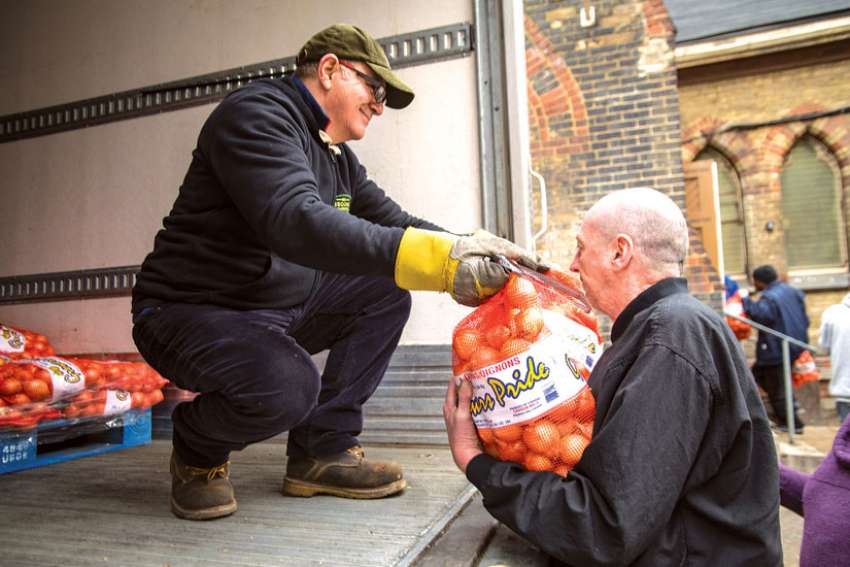Leon White, the kitchen manager, has the same question, but it’s not as if he’s picky. Margaret’s kitchen is open 24 hours, serving 350 meals and an endless stream of snacks morning, noon and night. Leon needs whatever is in that truck.
Operating out of an old United Church that has served Toronto’s homeless and hungry since 1984, Margaret’s relies heavily on food that Second Harvest rescues every day from warehouses, factories, farms, hotels and restaurants. But they’re just one of 225 agencies that take delivery from Second Harvest — including 82 food banks, drop-ins and open kitchens that rely solely on Second Harvest.
Second Harvest collects 4.3 million kilograms of food a year, which agencies translate into 25,000 meals a day.
On this particular January morning, Margaret’s is getting barbecue chicken, apple crumble and steamed vegetables from the Hot House Restaurant and Bar, carrots and cherry tomatoes that never made it into grocery stores, Pillsbury cinnamon rolls, frozen steaks and a generous supply of milk. Margaret’s clients line up to help Leon cart it back into the kitchen.
Canada’s largest food rescue operation knows the need for food is great and growing and the supply of waste food nearly endless. With help from a $747,600 grant from the Trillium Foundation over the next 33 months, Second Harvest plans to grow its food rescue efforts by 50 per cent by 2020. In four years, they will be collecting 6.8 million kilograms of food and distributing it to 280 agencies.
But the lottery and casino money from the Trillium Foundation is just a drop in the bucket. Second Harvest will need to raise another $28 million over the next four years to replace aging trucks and move into a larger warehouse.
Currently, it raises over $3 million a year to support its operation and takes in $23.7 million a year worth of food. All this is bolstered by over 12,000 hours of volunteer labour.
While Second Harvest provides food for many religiously affiliated food banks, drop-ins and meal programs, it remains a non-denominational organization, available to all.
The consulting firm Value Chain Management Centre pegs Canada’s wasted food at six billion kilos — enough to fill 60,000 rail cars, stretching along 1,000 kilometres of railway. An astonishing 31 per cent of all the food Canadians produce and import is thrown away.
About half the throw-away food is wasted by consumers who keep filling their green bins with mushy bags of rotted vegetables they find in a back corner of the fridge. Second Harvest concentrates on the other half — food they can rescue from manufacturers, wholesalers, distributors and even farmers.
Second Harvest and the Daily Bread Food Bank are the two major sources for food distributed to food banks and feeding programs. The two agencies complement each other, with Daily Bread sourcing food from grocery stores, the food industry and individual donors. Second Harvest focusses more exclusively on industry sources and diverting food out of the waste stream.
In 1985 Second Harvest started off with founders Ina Andre and Joan Clayton driving around to hotels and restaurants with their hatchback and delivering the prepared meals to soup kitchens and women’s shelters. Andre and Clayton were moved to action by images of starving Ethiopian children beamed by satellite into millions of Canadian living rooms, and by the “feed the world” movement that followed.
Second Harvest still picks up from a few hotel kitchens and restaurants that have large volumes. But since Queen’s Park passed the Donation of Food Act in 1994, releasing food donors from liability, Second Harvest has been able to move up the chain of food production and rescue ever larger amounts.
“That is where more of the food waste happens,” explains Second Harvest director of development Jennifer Verschraegen. “It happens as a result of an overrun on product which creates a surplus. Possibly things were mislabeled or mispackaged. It could be that the product was misshapen or is missing a key ingredient, so it’s perfectly edible, it’s just not what the manufacturer was looking for.”
As one of the most obvious signs of a “culture of waste,” wasted food is certainly something that irks Pope Francis.
“Throwing away food is like stealing from the table of the poor and the hungry,” Francis said in 2013.
“The whole concept of food rescue is still something relatively new to the consumer,” Verschraegen said. “We’re one of Toronto’s really well kept secrets. Usually when we talk about ourselves people say, ‘Oh yes, I know the food bank.’ ”
People rarely ask where the food bank or drop-ins and meal programs get their food.
Second Harvest puts nine trucks on the road every day, each making 13 to 18 stops picking up food and dropping it off for hungry people instead of watching it wind up as landfill.
Some of the programs that take Second Harvest food feed fewer than 20 people per day, but in every corner of Toronto they find hungry people. Half the places where Second Harvest delivers food say they expect the demand to feed more people in the coming year will increase 40 per cent.


